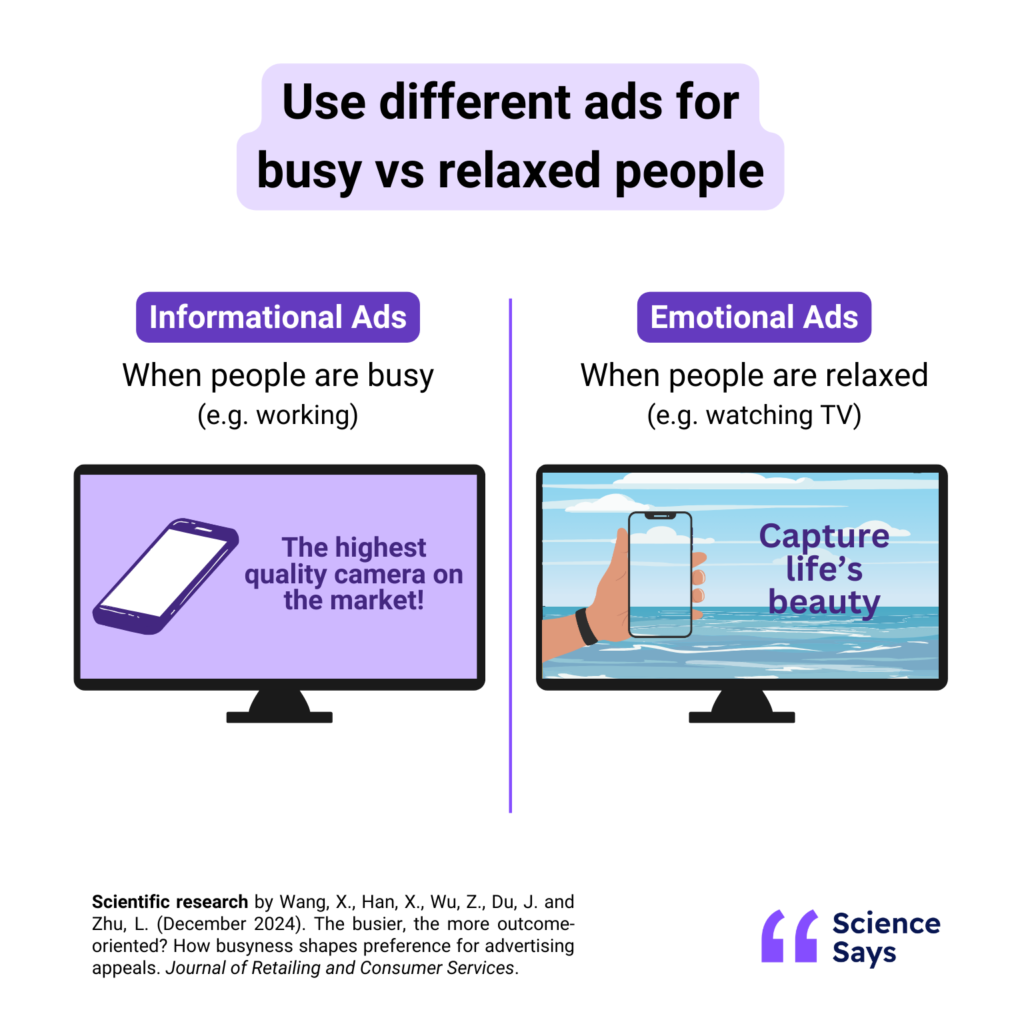Simple, informational ads are more effective for busy people (e.g. working on a project). Emotional ads are more effective for relaxed viewers (e.g. watching TV on the sofa).
You’re creating an ad for the launch of your new productivity app. You’re working with a marketing agency that delivers two concepts: A simple, informative ad. It highlights the key features and how the app helps people “get 30% more free time”.
An emotional and aspirational ad. It compares the lives of two busy, young professionals – one who struggles to keep up, and another one, an app user who has more time to enjoy their social life.
Which should you go for?
Science says it depends on the context and frame of mind people will be in when they see it.


When you’re targeting people who are busy or in a hurry (e.g. quickly scrolling their phone during their work hours), your ads should be informational, with clear and concise messaging on the product’s features and benefits.
When your audience is relaxed (e.g. relaxing on a Sunday), focus your ad on emotions, storytelling, and experiences.
People will like your product more.
Findings:
Busy people (e.g. juggling 3 chores at the same time) like a product more when its ad provides clear information with key benefits.
Relaxed people (e.g. strolling at a shopping mall on weekends) prefer when a product is advertised with emotional ads.
In experiments and an analysis of 570,000+ mobile ad views, researchers found that busy people:
- Liked headphones 18.1% more when the sound quality was highlighted (vs the joy of using them), while less busy people liked them 7.1% more when the ad highlighted emotional appeal (vs quality).
- Rated a language learning course 9.5% better when its benefits were highlighted (vs the emotional appeal of learning a new language). By contrast, less busy people liked it 11% better when the latter message was highlighted.
- Were more likely to click on an ad with a rational message (vs an emotional one), and vice versa.
Why it works:
When we’re busy, we’re more focused on conserving resources for pressing demands (e.g. making a deadline).
Our attention shifts to focus on essentials and the end goal to maximize how easily we can finish a task. If, when busy, we are shopping for a product, this increases the importance we give to the main benefits of it, like its functionality.
Our need for quick, actionable information makes us more receptive to messages that are clear, practical, and concise.
In contrast, when we have more time and attention to give, the process (compared to the end result) becomes more valuable to us. When we’re in the mood to explore, we engage our emotions when learning information and making decisions.
In this mindset, we prefer ads that highlight emotions or experiences.
Limitations:
- The researchers focused on customers’ opinions of a product. They did not look at whether the type of messaging impacted actual sales.
- The study didn’t compare different types of products. Other research shows that informational ads work best for functional products, while emotional ads work best for pleasurable products.
- The study was conducted in China. Chinese perceptions of business and leisure and how they affect ad preferences might not be generalizable across all cultures.
→ It hasn’t been tested, but for example, equally busy people in another culture may still prefer emotional ads over informative ones.
Companies using this:
- Social media influencer posts often feature them talking about “a busy day” or a “day filled with appointments” before diving into the features and benefits of products, making the product choices seem more rational and efficient.
- Many brands already differentiate their campaigns for specific placements.
Examples:
- In the travel industry:
→ Billboards (seen by people for a shorter time as they’re hurrying by) focus on prices and deals
→ TV and video ads highlight the experience of visiting a destination and creating rich imagery - For personal care products:
→ Static ads highlight facts (e.g. a shampoo’s effectiveness in removing dandruff)
→ Video ads make an emotional appeal (e.g. having dandruff on clothing when going out with friends) - Car companies:
→ Highlight the feeling of driving the car through scenic landscapes in TV commercials
→ Billboards focus on key features like fuel efficiency and engine power - Ads at subway stations:
→ Where people are rushing by, tend to focus on functional messaging – prices – rather than the emotional aspects of visiting a new destination.
Steps to implement:
- When media buying or choosing ad placements, consider the location, medium, and timings of your ad viewing to decide if people will be seeing them when busy or relaxed.
- If your audience is busy (e.g. social media ads during working hours), focus on straightforward, factual messaging.
- If your audience is relaxed (e.g. seeing a TV ad during a comedy show), focus on emotional messaging, triggering people’s senses, or showing the experience of using your product.
- Be careful, since research shows that informational ads work better for functional products and emotional ads for pleasurable products. These different effects, in combination with each other, could lead to unexpected results.
→ For example, targeting commuters with rational ads for junk food could fall flat compared to using more emotional appeals.
Source: Science Says.
Related:










